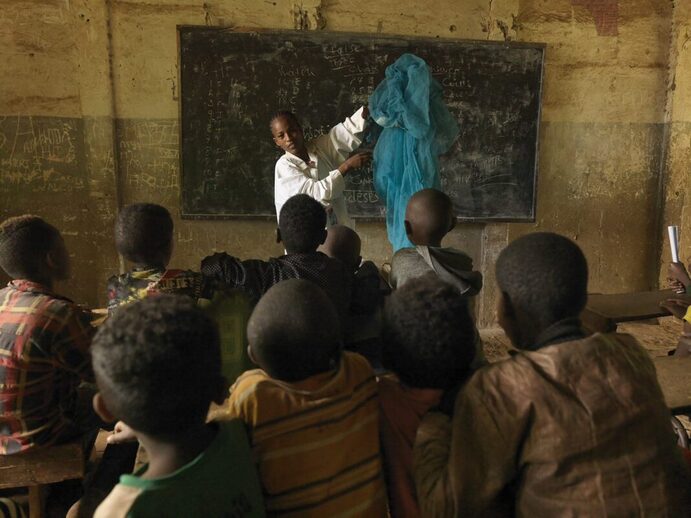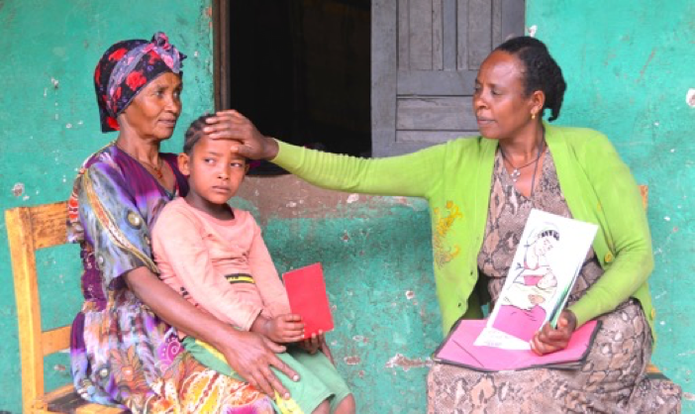Malaria
Completed projects
Malaria is one of the top 10 causes of mortality among children under 5 in Ethiopia. SNNPR has one of the highest malaria burdens in Ethiopia - accounting for 15 percent of the total malaria caseload and 34 percent of total malaria deaths reported at the national level for the year 2016/2017.
Knowledge about malaria is low, according to the Ethiopian Malaria Indicator Survey (MIS 2015), 28 percent of respondents did not recognise fever as a symptom of malaria; 28 percent did not know that malaria is transmitted by mosquitoes; and 28 percent did not know that Long-Lasting Insecticidal Nets (LLINs) can prevent malaria.
This project focused on reducing malaria morbidity and severity in the Boloso Sore and Damot Sore districts of Ethiopia. Malaria Consortium is strengthening community-based malaria services through improved planning and engagement across the health system. This project provided indoor residual spraying of long-lasting insecticide to kill adult vector mosquitoes and supported the distribution of long-lasting insecticidal bed nets. Health extension workers were trained to detect malaria outbreaks and people in at-risk areas were provided with information on malaria effective prevention techniques, common symptoms and how to seek care.
As a result, during the grant period:
Knowledge about malaria is low, according to the Ethiopian Malaria Indicator Survey (MIS 2015), 28 percent of respondents did not recognise fever as a symptom of malaria; 28 percent did not know that malaria is transmitted by mosquitoes; and 28 percent did not know that Long-Lasting Insecticidal Nets (LLINs) can prevent malaria.
This project focused on reducing malaria morbidity and severity in the Boloso Sore and Damot Sore districts of Ethiopia. Malaria Consortium is strengthening community-based malaria services through improved planning and engagement across the health system. This project provided indoor residual spraying of long-lasting insecticide to kill adult vector mosquitoes and supported the distribution of long-lasting insecticidal bed nets. Health extension workers were trained to detect malaria outbreaks and people in at-risk areas were provided with information on malaria effective prevention techniques, common symptoms and how to seek care.
As a result, during the grant period:
- The annual parasite incidence (new malaria cases per 1,000 people) has decreased from 15.6 to 5.6 in Boloso Sore district and from 29.7 to 7 in Damot Sore district.
- There was an increase from 41% to 72% of people with access to a bed net in their house
- 92% of people can now recognize fever as a main symptom of malaria and 91% of people can name mosquitoes as the cause
- 100% of health facilities are now reporting complete, timely and quality data, up from 76% at baseline.
Despite the Ethiopian government’s efforts to provide key interventions and services, Ethiopia’s population suffers from a high burden of preventable disease. In the Southern Nations, Nationalities and Peoples Region (SNNPR), febrile illnesses are the leading cause of sickness and death for children under five, with malaria accounting for one-fifth of all in-patient and out-patient cases (as per the Regional Health Bureau Report 2013 ). The Boloso Sore and Halaba districts in SNNPR are widely known to be highly affected by episodic outbreaks of malaria.
This three-year project aimed to improve the use and effectiveness of community-based health services to reduce child morbidity and mortality in the Boloso Sore and Halaba Districts by strengthening existing community referral systems and increasing the uptake of such services using social behaviour change communication activities to change attitudes and behaviours towards malaria prevention interventions.
Some of the activities that Malaria Consortium were able to implement thanks to this grant include: (i) organisation of 111 road shows where 400,000 people from local communities learnt about malaria prevention and treatment through educational movies and activities, (ii) distribution of posters, booklets and leaflets to 114 health posts to help health extension workers raise awareness and (ii) training 238 health workers to provide effective supportive supervision for health extension workers to improve their performance in service delivery and quality of care at community level.
As a result, during the grant period:
- The percentage of children under five with fever referred to health extension workers by Health Development Army volunteers increased from 33% to 73%.
- The percentage of children under five with fever seeking treatment within 24 hours increased from 46% to 70%.
- This project contributed to a significant decrease in the number of outpatient malaria cases in the project districts (from 44,681 cases in 2014 to 4,070 in 2017, a reduction of 91%).
James Percy Foundation
Registered with the Charity Commission 1144494
Registered with the Charity Commission 1144494



